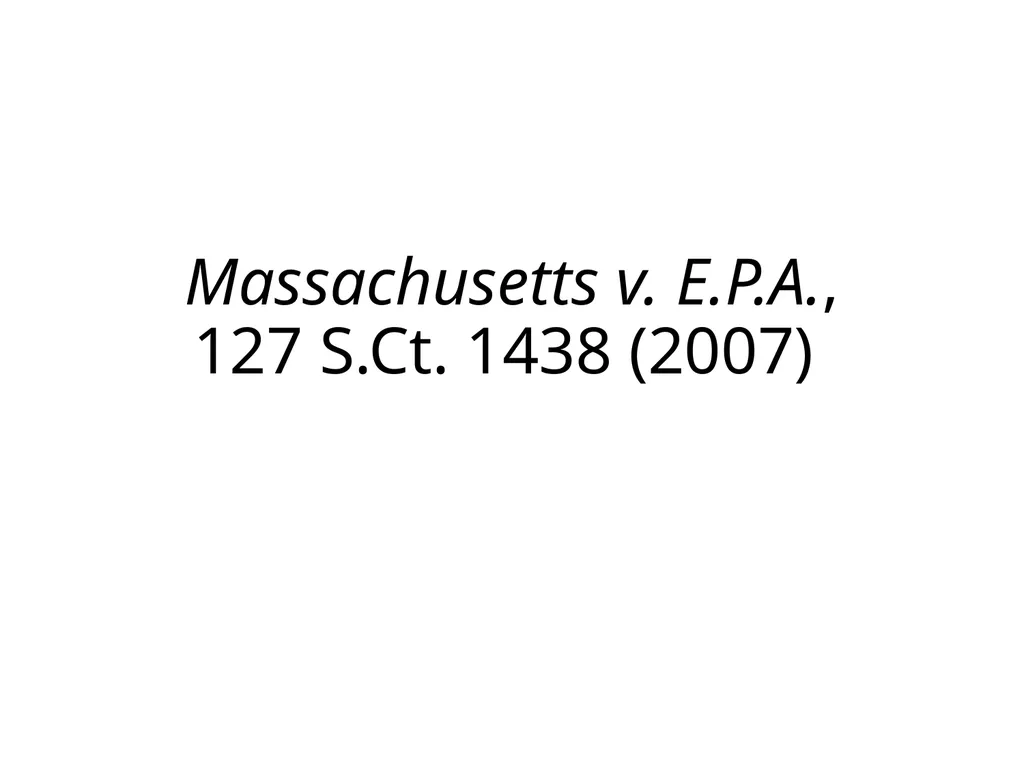Massachusetts v. E.P.A., 127 S.Ct. 1438 (2007)
Author : kittie-lecroy | Published Date : 2025-11-08
Description: Massachusetts v EPA 127 SCt 1438 2007 Brief Review of Standing The majority accepts specific claims of injury by the state to its property and that of its citizens as satisfying Lujan standing requirements The dissent strongly
Presentation Embed Code
Download Presentation
Download
Presentation The PPT/PDF document
"Massachusetts v. E.P.A., 127 S.Ct. 1438 (2007)" is the property of its rightful owner.
Permission is granted to download and print the materials on this website for personal, non-commercial use only,
and to display it on your personal computer provided you do not modify the materials and that you retain all
copyright notices contained in the materials. By downloading content from our website, you accept the terms of
this agreement.
Transcript:Massachusetts v. E.P.A., 127 S.Ct. 1438 (2007):
Massachusetts v. E.P.A., 127 S.Ct. 1438 (2007) Brief Review of Standing The majority accepts specific claims of injury by the state to its property and that of its citizens as satisfying Lujan standing requirements. The dissent strongly rejects this as failing Lujan It is not particularized because it affects everyone, just in different ways. It is not imminent in that the claim is based on fears of future damage. It is not redressable through litigation because it is a global regulatory and policy problem that should be address through legislation. Key votes for standing are gone, replaced with judges that are expected to side with the dissent. This will be critical in the state tort cases against oil companies. 2 What were EPA’s Two Findings When it Answered the Rulemaking Petition? (1) that contrary to the opinions of its former general counsels, the Clean Air Act does not authorize EPA to issue mandatory regulations to address global climate change, see id., at 52925-52929; and (2) that even if the agency had the authority to set greenhouse gas emission standards, it would be unwise to do so at this time. The EPA had previously said it had the authority to regulate GHGs. By denying it had the authority, it gave the court a pure legal question to answer – could the CAA cover GHGs? 3 What does the Clean Air Act §7521(a)(1) require the EPA to issue regulations on? [35] "The [EPA] Administrator shall by regulation prescribe (and from time to time revise) in accordance with the provisions of this section, standards applicable to the emission of any air pollutant from any class or classes of new motor vehicles or new motor vehicle engines, which in his judgment cause, [key to the dissent] or contribute to, air pollution which may reasonably be anticipated to endanger public health or welfare ... [36] The Act defines "air pollutant" to include "any air pollution agent or combination of such agents, including any physical, chemical, biological, radioactive ... substance or matter which is emitted into or otherwise enters the ambient air." §7602(g). "Welfare" is also defined broadly: among other things, it includes "effects on ... weather ... and climate." §7602(h). 4 Does the CAA Give the EPA Authority to Regulate GHGs? The Court uses the rule from the Chevron case to decide what the CAA means for GHGs. The question in Chevron was how should













